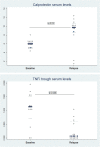Calprotectin strongly and independently predicts relapse in rheumatoid arthritis and polyarticular psoriatic arthritis patients treated with tumor necrosis factor inhibitors: a 1-year prospective cohort study
- PMID: 30545393
- PMCID: PMC6292085
- DOI: 10.1186/s13075-018-1764-z
Calprotectin strongly and independently predicts relapse in rheumatoid arthritis and polyarticular psoriatic arthritis patients treated with tumor necrosis factor inhibitors: a 1-year prospective cohort study
Abstract
Background: Calprotectin is a biomarker of disease activity in rheumatoid arthritis (RA) and psoriatic arthritis (PsA) and predicts relapse in juvenile idiopathic arthritis. Higher drug trough serum levels are associated with a good response in patients treated with tumor necrosis factor inhibitors (TNFi). Power Doppler ultrasound synovitis is predictive of relapse and structural damage progression in patients in clinical remission. The purpose of this study was to analyze the accuracy of serum calprotectin levels, drug trough serum levels (TSL), and power Doppler (PD) activity as predictors of relapse in RA and PsA patients in remission or with low disease activity receiving TNFi.
Methods: This was a longitudinal, prospective, 1-year single-center study of 103 patients (47 RA, 56 PsA) receiving TNFi in remission or with low disease activity (28-joint Disease Activity Score (DAS28) ≤ 3.2). The predictive value of serum calprotectin, TNFi TSL, and PD were assessed using receiver operating characteristic (ROC) analyses. To illustrate the predictive performance of calprotectin, TNFi TSL, and PD score, Kaplan-Meier curves were constructed from baseline to relapse. Associations between baseline factors and relapse were determined using Cox regression models. Multivariate models were constructed to analyze the effect of covariates and to fully adjust the association between calprotectin, TNFi TSL, and PD score with relapse. A generalized estimating equation model with an identity link for longitudinal continuous outcomes was used to assess the effect of covariates on TNFi TSL.
Results: Ninety-five patients completed 1 year of follow-up, of whom 12 experienced a relapse. At baseline, relapsers had higher calprotectin levels, lower TNFi TSL, and higher PD activity than nonrelapsers. ROC analysis showed calprotectin fully predicted relapse (area under the curve (AUC) = 1.00). TNFi TSL and PD had an AUC of 0.790 (95% confidence interval (CI) 0.691-0.889) and 0.877 (95% CI 0.772-0.981), respectively. Survival analyses and log rank tests showed significant differences between groups according to calprotectin serum levels (p < 0.001), TNFi TSL (p = 0.004), and PD score (p < 0.001). Univariate Cox regression models showed that time-to-remission/low disease activity (hazard ratio (HR) = 1.17, p < 0.001), calprotectin levels (HR = 2.38, p < 0.001), TNFi TSL (HR = 0.47, p = 0.018), and PD score (HR = 1.31, p < 0.001) were significantly associated with disease relapse. In the multivariate analysis, only baseline calprotectin levels independently predicted disease relapse (HR = 2.41, p = 0.002). The generalized estimating equation analysis showed that only disease activity by DAS28-erythrocyte sedimentation rate (ESR) was significantly associated with longitudinal changes in TNFi TSL (regression coefficient 0.26 (0.0676 to 0.0036), p = 0.001).
Conclusion: Time-to-remission/low disease activity, calprotectin serum levels, TNFi TSL, and PD score were significantly associated with disease relapse. However, only baseline calprotectin serum levels independently predicted disease relapse in RA and PsA patients under TNFi therapy.
Keywords: Biomarkers; Calprotectin; Predictors; Psoriatic arthritis; Relapse; Rheumatoid arthritis; TNFi serum trough levels; Ultrasound.
Conflict of interest statement
Ethics approval and consent to participate
This study was conducted in accordance with the Declaration of Helsinki and was approved by the Hospital Clínic of Barcelona Clinical Research Ethics Committee (Reg. 2013/8382). Signed informed consent was obtained from all patients before study enrolment.
Consent for publication
Not applicable.
Competing interests
The authors declare that they have no competing interests.
Publisher’s Note
Springer Nature remains neutral with regard to jurisdictional claims in published maps and institutional affiliations.
Figures


References
-
- Brown AK, Quinn MA, Karim Z, Conaghan PG, Peterfy CG, Hensor E, et al. Presence of significant synovitis in rheumatoid arthritis patients with disease-modifying antirheumatic drug-induced clinical remission: evidence from an imaging study may explain structural progression. Arthritis Rheum. 2006;54:3761–3773. doi: 10.1002/art.22190. - DOI - PubMed
-
- Scirè CA, Montecucco C, Codullo V, Epis O, Todoerti M, Caporali R. Ultrasonographic evaluation of joint involvement in early rheumatoid arthritis in clinical remission: power Doppler signal predicts short-term relapse. Rheumatology. 2009;48:1092–1097. doi: 10.1093/rheumatology/kep171. - DOI - PubMed
-
- Berntzen HB, Munthe E, Fagerhol MK. A longitudinal study of the leukocyte protein L1 as an indicator of disease activity in patients with rheumatoid arthritis. J Rheumatol. 1989;16:1416–1420. - PubMed
Publication types
MeSH terms
Substances
LinkOut - more resources
Full Text Sources
Medical
Research Materials
Miscellaneous

